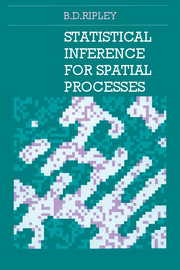5 - Modelling spatial images
Published online by Cambridge University Press: 05 June 2012
Summary
Images as data are occurring increasingly frequently in a wide range of scientific disciplines. The scale of the images varies widely, from meteorological satellites which view scenes thousands of kilometres square and optical astronomy looking at sections of space, down to electron microscopy working at scales of 10µm or less. However, they all have in common a digital output of an image. With a few exceptions this is on a square grid, so each output measures the image within a small square known as a pixel. The measurement on each pixel can be a greylevel, typically one of 64 or 256 levels of luminance, or a series of greylevels representing luminance in different spectral bands. For example, earth resources satellites use luminance in the visual and infrared bands, typically four to seven numbers in total. One may of course use three bands to represent red, blue and green and so record an arbitrary colour on each pixel.
The resolution (the size of each pixel, hence the number of pixels per scene) is often limited by hardware considerations in the sensors. Optical astronomers now use 512 × 512 arrays of CCD (charge coupled device) sensors to replace photographic plates. The size of the pixels is limited by physical problems and also by the fact that these detectors count photons, so random events limit the practicable precision. In many other applications the limiting factor is digital communication speed. Digital images can be enormous in data-processing terms.
- Type
- Chapter
- Information
- Statistical Inference for Spatial Processes , pp. 73 - 120Publisher: Cambridge University PressPrint publication year: 1988



